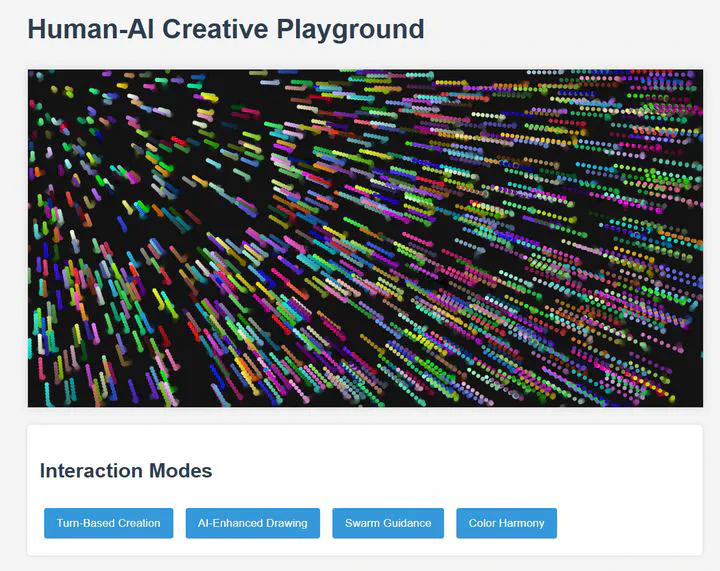Human-AI Collaboration in Creative Coding

In my latest experiment with creative coding, I embarked on a project to build an interactive particle system that showcases the fascinating synergy between human input and AI-driven behavior—all using p5.js. This project marries vibrant visual effects with innovative collaboration modes, creating an engaging canvas where thousands of particles respond dynamically to your gestures.
Four Modes of Collaboration
1. Turn-Based Creation: A Dance of Influences
In this mode, human and AI take turns directing the particle swarm. The alternating influence creates a fascinating rhythm, where periods of user-directed motion are interspersed with AI-driven organic flow. This back-and-forth showcases how different creative “minds” can build upon each other’s contributions.
2. AI-Enhanced Drawing: Amplifying Human Gestures
Here, we see the AI acting as an artistic amplifier. Simple human strokes are transformed into complex, procedurally generated patterns. This mode demonstrates how AI can extend and enhance human creativity, turning basic inputs into rich, detailed outputs.
3. Swarm Guidance: Shared Control
Inspired by natural flocking behaviors, this mode allows users to guide the overall direction of the particle swarm while the AI maintains internal cohesion and alignment. It’s a beautiful metaphor for collaborative leadership – setting a direction while allowing for self-organization.
4. Color Harmony: Emergent Aesthetics
In our newest mode, we explore how simple rules of color interaction can lead to complex, evolving palettes. As particles influence each other’s colors based on proximity, and user interaction shifts the underlying color palette, we witness the emergence of dynamic, harmonious color fields.
Technical Parts
Beyond the creative aspects, this project showcases several technical innovations in interactive digital art:
- Efficient Spatial Partitioning: By dividing the canvas into a grid, we dramatically reduce the computational cost of particle interactions, allowing for smooth performance even with thousands of elements.
- Touch-Enabled Interaction: Full support for touch devices brings this experience to mobile platforms, expanding the reach of creative coding experiences.
- Dynamic Parameter Adjustment: Easy-to-modify parameters allow for rapid experimentation and fine-tuning of the system’s behavior.
The Future of Creative Collaboration
Projects like the Human-AI Creative Playground point towards a future where the boundaries between human and artificial creativity become increasingly blurred. In this project, I set out to merge interactive art with intelligent systems—using p5.js for creative coding and ml5.js for on-the-fly AI analysis—to create an environment where human input not only shapes but also collaborates with algorithmic processes.
Rather than fearing AI as a replacement for human artists, this project celebrates the synergy between human ingenuity and machine precision. With interactive elements that respond to mouse and touch events, along with a particle system that adapts based on spatial dynamics and AI-driven visual feedback, the code is a testament to the endless possibilities when technology and art intersect. The system isn’t static; it evolves as you interact with it, mirroring the dynamic and ever-changing landscape of creative expression.
As we continue to develop and refine this system, I’m excited to see how artists, designers, and creative coders will use and extend it. The possibilities for education, interactive installations, and new forms of digital art are boundless. I invite you to dive into the Human-AI Creative Playground—experiment with its various modes, contribute your insights, and share your creative outputs. Together, we can push the boundaries of what’s possible when human creativity meets artificial intelligence.